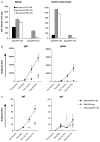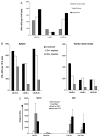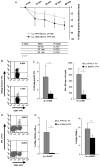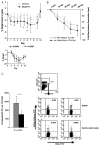A comparative analysis of HIV-specific mucosal/systemic T cell immunity and avidity following rDNA/rFPV and poxvirus-poxvirus prime boost immunisations
- PMID: 21352941
- PMCID: PMC3244379
- DOI: 10.1016/j.vaccine.2011.01.106
A comparative analysis of HIV-specific mucosal/systemic T cell immunity and avidity following rDNA/rFPV and poxvirus-poxvirus prime boost immunisations
Abstract
In this study we have firstly compared a range of recombinant DNA poxvirus prime-boost immunisation strategies and shown that combined intramuscular (i.m.) 2× DNA-HIV/intranasal (i.n.) 2× FPV-HIV prime-boost immunisation can generate high-level of HIV-specific systemic (spleen) and mucosal (genito-rectal nodes, vaginal tissues and lung tissues) T cell responses and HIV-1 p24 Gag-specific serum IgG1, IgG2a and mucosal IgG, SIgA responses in vaginal secretions in BALB/c mice. Data indicate that following rDNA priming, two rFPV booster immunisations were necessary to generate good antibody and mucosal T cell immunity. This data also revealed that mucosal uptake of recombinant fowl pox (rFPV) was far superior to plasmid DNA. To further evaluate CD8+ T cell immunity, i.m. 2× DNA-HIV/i.n. 1× FPV-HIV immunisation strategy was directly compared with single shot poxvirus/poxvirus, i.n. FPV-HIV/i.m. VV-HIV immunisation. Results indicate that the latter strategy was able to generate strong sustained HIV-specific CD8+ T cells with higher avidity, broader cytokine/chemokine profiles and better protection following influenza-K(d)Gag(197-205) challenge compared to rDNA poxvirus prime-boost strategy. Our findings further substantiate the importance of vector selection/combination, order and route of delivery when designing effective vaccines for HIV-1.
Copyright © 2011 Elsevier Ltd. All rights reserved.
Figures







Similar articles
-
Novel HIV IL-4R antagonist vaccine strategy can induce both high avidity CD8 T and B cell immunity with greater protective efficacy.Vaccine. 2014 Sep 29;32(43):5703-14. doi: 10.1016/j.vaccine.2014.08.023. Epub 2014 Aug 20. Vaccine. 2014. PMID: 25151041
-
Evaluation of fowlpox-vaccinia virus prime-boost vaccine strategies for high-level mucosal and systemic immunity against HIV-1.Vaccine. 2006 Jul 26;24(31-32):5881-95. doi: 10.1016/j.vaccine.2006.04.023. Epub 2006 May 2. Vaccine. 2006. PMID: 16759767
-
Mucosal Priming with a Recombinant Influenza A Virus-Vectored Vaccine Elicits T-Cell and Antibody Responses to HIV-1 in Mice.J Virol. 2021 May 24;95(12):e00059-21. doi: 10.1128/JVI.00059-21. Print 2021 May 24. J Virol. 2021. PMID: 33789991 Free PMC article.
-
Prime-boost strategies in DNA vaccines.Methods Mol Med. 2006;127:171-97. doi: 10.1385/1-59745-168-1:171. Methods Mol Med. 2006. PMID: 16988455 Review.
-
Aiming for protective T-cell responses: a focus on the first generation conserved-region HIVconsv vaccines in preventive and therapeutic clinical trials.Expert Rev Vaccines. 2019 Oct;18(10):1029-1041. doi: 10.1080/14760584.2019.1675518. Epub 2019 Oct 15. Expert Rev Vaccines. 2019. PMID: 31613649 Review.
Cited by
-
Mucosal and systemic SIV-specific cytotoxic CD4+ T cell hierarchy in protection following intranasal/intramuscular recombinant pox-viral vaccination of pigtail macaques.Sci Rep. 2019 Apr 5;9(1):5661. doi: 10.1038/s41598-019-41506-5. Sci Rep. 2019. PMID: 30952887 Free PMC article.
-
Emerging Targets for Developing T Cell-Mediated Vaccines for Human Immunodeficiency Virus (HIV)-1.Front Microbiol. 2017 Oct 25;8:2091. doi: 10.3389/fmicb.2017.02091. eCollection 2017. Front Microbiol. 2017. PMID: 29118747 Free PMC article. Review.
-
Increase in DNA vaccine efficacy by virosome delivery and co-expression of a cytolytic protein.Clin Transl Immunology. 2014 Jun 27;3(6):e18. doi: 10.1038/cti.2014.13. eCollection 2014 Jun. Clin Transl Immunology. 2014. PMID: 25505966 Free PMC article.
-
Role of novel type I interferon epsilon in viral infection and mucosal immunity.Mucosal Immunol. 2012 Nov;5(6):610-22. doi: 10.1038/mi.2012.35. Epub 2012 May 23. Mucosal Immunol. 2012. PMID: 22617838 Free PMC article.
-
IL-12 and GM-CSF in DNA/MVA immunizations against HIV-1 CRF12_BF Nef induced T-cell responses with an enhanced magnitude, breadth and quality.PLoS One. 2012;7(5):e37801. doi: 10.1371/journal.pone.0037801. Epub 2012 May 24. PLoS One. 2012. PMID: 22655069 Free PMC article.
References
-
- Kelleher AD, Puls RL, Bebbington M, Boyle D, Ffrench R, Kent SJ, et al. A randomised, placebo-controlled phase I trial of DNA prime, recombinant fowlpox virus boost prophylactic vaccine for HIV-1. AIDS. 2006;20(2):294–7. - PubMed
-
- Kaul R, Plummer FA, Kimani J, Dong T, Kiama P, Rostron T, et al. HIV-1-specific mucosal CD8+ lymphocyte responses in the cervix of HIV-1-resistant prostitutes in Nairobi. J Immunol. 2000;164:1602–11. - PubMed
-
- Kozlowski PA, Neutra MR. The role of mucosal immunity in prevention of HIV transmission. Curr Mol Med. 2003;3(3):217–28. - PubMed
-
- Stevceva L, Strober W. Mucosal HIV vaccines: where are we now? Curr HIV Res. 2004;2(1):1–10. - PubMed
Publication types
MeSH terms
Substances
Grants and funding
LinkOut - more resources
Full Text Sources
Other Literature Sources
Medical
Research Materials

